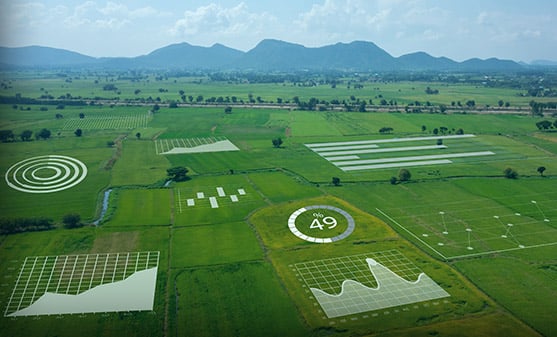Embracing Innovation: What Marketers Need To Know About AI In Ag
Game-changing AI trends in agriculture
Artificial intelligence is infiltrating the marketplace, with more than 14,000 AI-based startups in the U.S. alone. Many industries have begun to harness the power of AI in their fields, and agriculture is no exception. In fact, of the 14,000 AI startups, 1,258 were in agriculture. Investment in AI in the ag sector is booming. Research suggests that the market size of AI in agriculture should see a compound annual growth rate close to 22% and reach $4 billion by 2027.
While generative AI programs such as ChatGPT are being employed more in agriculture marketing, other forms of AI have been making their way into agriculture for several years. As ag marketers, it’s important to stay on top of the latest technology trends in order to best serve our customers. Staying current on AI, how it’s used and the impacts improves our understanding of agriculture, giving us context of the landscape. That helps us make better, more strategic decisions.
In 2023, most AI innovations in agriculture fall into the categories of precision agriculture and synthetic data.
PRECISION AGRICULTURE
You’re likely familiar with the term precision agriculture. Farmers have been using precision ag technology like auto-steer and variable rate technology for years to incorporate crop data, detailed nutrition plans, and pinpoint-accurate fertilizer application to help better manage their crops. Powered by AI, precision agriculture increasingly provides new ways for farmers to be more efficient.
Precision Farming Dealer lists 10 companies paving the way for precision ag. Their innovations span from autonomous robots to drone technology to metagenomics, which analyzes the genetic composition of microbial communities. Included in that list is Blue River, a subsidiary of John Deere. Blue River offers “intelligent” crop sprayers that use a machine learning technology known as PyTorch to optimize the crop-treating process. High-framerate cameras in the sprayer collect real-time data about the field, which is subsequently analyzed by PyTorch. As PyTorch differentiates between weed and crop, a pixel-accurate map of the field is created, allowing the sprayer to stay on target and reduce herbicide waste by an impressive 90%.
SYNTHETIC DATA
Synthetic data is used alongside AI models to help farmers better understand potential outcomes for their crops. Synthetic data is typically produced using a model that applies real-world data to create a “digital twin.” With this synthetic data, farmers can target variables like soil content and weather conditions to help them predict how their crops would respond to specific environmental changes.
One of the companies at the forefront of synthetic data use in farming is Agmatix, an agriculture informatics firm with 670 million data points at its disposal. This data is principally used to create digital twins, or synthetic data, for crop protection companies and seed suppliers alike. The resulting simulations allow these companies to see the efficacy of their products under certain conditions, leading to a wealth of knowledge concerning product performance in the field. With the higher degree of precision and adaptability offered compared to its real-world counterpart, it is no surprise that synthetic data is growing in popularity with farmers.
Farmers face many challenging and often unpredictable hurdles, including labor shortages, changing weather patterns and price fluctuations to name just a few. Yet they are being asked to more efficiently produce more food to feed a growing global population. AI tools like autonomous equipment and synthetic data are transforming the industry and helping farmers optimize their operations to increase overall efficiency and open new possibilities for their businesses.
As marketers, we have a unique opportunity to shape the narrative around emerging technologies and growth. It’s crucial that we recognize the potential of artificial intelligence and find effective ways to engage with farmers and help them understand its benefits. By meeting farmers where they are and speaking their language, we can help arm this target audience with the knowledge to embrace these emerging technologies and more rapidly leverage them for business growth.
Our team at Rhea + Kaiser is also studying AI technology to understand how these tools can make us more efficient in our marketing roles. And we are going to share those learnings with you. Keep an eye out for a future blog post where we highlight our recent AI insights. In the meantime, check out this blog post about precision ag and what farmers want to know about new precision ag technology.
Never miss an article.
Get the latest sent straight to your inbox.
Related Articles
Overcoming barriers to find value in agricultural technology
They say the ...



